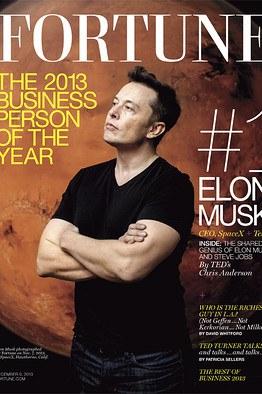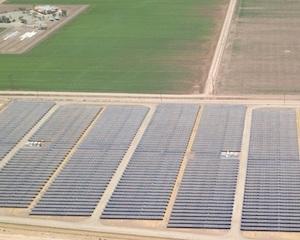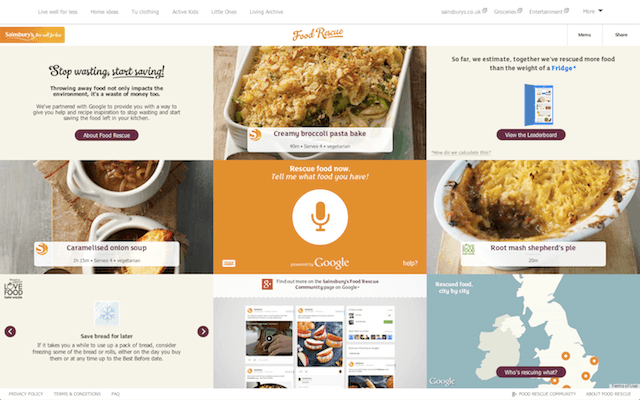Elon Musk (Again) Demonstrates Sustainable CEO Leadership


Tesla Motors founder Elon Musk has once again demonstrated business leadership by offering a business solution to climate change. Musk’s act of leadership is to open-source his company’s invaluable intellectual property for building world-class electric cars to the global auto industry. Musk's actions must look crazy to many business leaders and Wall Street “financial engineers,” and they must be questioning whether it violates Musk’s fiduciary obligation to shareholders. In fact, Musk has once again demonstrated real business leadership by creating a viable path to solving climate change that also holds the potential of accelerating his company’s financial success.
100 million fossil fueled vehicles per year is not sustainable
The global auto industry produces 100 million fossil fuel vehicles annually. (In comparison, the U.S. fleet of automobiles is approximately 250 million.) This is not sustainable in the face of climate change, continued sectarian wars in the Middle East, and the price of oil defined by its escalating and volatile pump price. Electric cars with their zero tailpipe emissions, especially if the electricity is supplied from zero-emissions renewable energy like solar and wind, is a solution. Musk’s vision is that the electric car can deliver exciting performance and cost-effective operations without damaging our planet or our health. Musk’s actions to remove the legal barriers to his company’s cutting-edge technology opens the door to realizing a sustainable car industry.
Musk defines business leadership
With rare exceptions, corporate business leadership today is defined by the CEO’s fiduciary responsibility to investors. The reward for this practice is evident by the fact that CEO compensation between 1978 and 2013 has jumped an inflation-adjusted 937 percent. The CEO compensation among the largest 350 U.S. companies now averages $15 million per year. In comparison, during this time period the stock market’s valuation only doubled. The income for the typical worker during this time period grew only 10.2 percent.
During this time period, did this CEO focus on fiduciary responsibility deliver sustainable solutions? Based on the evidence, the answer is no. We are just now recovering from a Great Recession created by CEO actions that lacked prudence in their management of debt and business policies. We now view in our mirrors the consequences of eating an industrially manufactured diet promoted through value meals that has made us fatter and created a global obesity epidemic. The execution of fiduciary responsibility defined by realizing quarterly profits has created a fossil fuel-based economy where we are addicted to oil. To protect our addiction we have engaged in several Middle Eastern wars that have cost trillions of dollars plus thousands of causalities without solving the negative economic impacts of pump price pain. And our fossil fuel addiction has also delivered climate change that threatens our health and wealth through increasingly volatile storms and weather extremes.
Musk’s leadership is a challenge to every CEO. Sustainability is not a poor sister to the CEO focus on quarterly profitability. Sustainability is at the core of every business purpose and the key element of business strategy. If a CEO is not delivering sustainable solutions, then they will not deliver sustainable profits. Winning profits by abusing credit is not sustainable. Winning profits through the creation of oligopolies that can dictate consumer prices is profitable but highly damaging to a free market economy and a democratic form of government. Growing profits through political lobbying to win tax benefits not tied to a sustainable benefit is a threat to society. Without overvaluing Musk’s efforts, his action to balance fiduciary responsibility in pursuit of sustainable solutions is the definition of business leadership.
Musk’s sustainable solution is good business
Musk’s choice to open-source his company’s patents is also good business. Sustainable solutions must achieve mass production to gain the economies of scale that enable competitive pricing. The solar industry has proven this in the states that allow net metering. The fall in panel price due to economies of scale has made rooftop solar price-competitive with retail electricity prices.
This is Musk’s strategy for electric cars. Electric cars must achieve manufacturing economies of scale to become price competitive against fossil fueled cars. Electric cars need the same extensive recharging network as we now have for gasoline. Musk is opening Tesla Motors' patents to the auto industry to accelerate the path to lower prices through economies of scale. He does so confident that his company will be competitive in this envisioned larger market. That is good business. It is also leadership. Combined, it offers real hope to creating sustainable solutions for energy independence, economic growth and climate change.
Bill Roth is an economist and the Founder of Earth 2017. He coaches business owners and leaders on proven best practices in pricing, marketing and operations that make money and create a positive difference. His book, The Secret Green Sauce, profiles business case studies of pioneering best practices that are proven to win customers and grow product revenues. Follow him on Twitter: @earth2017
EDF: Green Trucks Good for the Planet and Business


A report released last week by the Environmental Defense Fund and Ceres says that strong fuel efficiency and greenhouse gas (GHG) emission standards for freight trucks could slash fuel consumption by as much as 40 percent compared to 2010 levels, resulting in significant environmental and economic benefits.
In fact, the report suggests that American businesses could save more than $25 billion if the National Highway Traffic Safety Administration and the U.S. Environmental Protection Agency adopt stringent fuel efficiency and GHG standards. The two agencies were tasked by President Barack Obama to come up with proposed target standards for medium- and heavy-duty trucks by March 2015.
Heavy trucks haul about 70 percent of U.S. freight, gobbling nearly 2.5 million barrels of oil per day while producing nearly half-a-billion tons of carbon pollution a year, according to the report. By 2040, pollution from this sector is projected to increase by another 40 percent.
In 2011, the first-ever fuel efficiency and GHG standards for medium- and heavy-duty trucks — those manufactured between 2014 and 2018 — were adopted. “While a good first step, the current standards don’t take advantage of many cost-effective technologies that have been identified by the National Research Council and demonstrated through the Department of Energy’s Super Truck program,” the EDF report says. This year NHTSA and EPA began developing so-called Phase 2 fuel efficiency and GHG standards for heavy-duty trucks for 2019 and beyond.
Ceres, a nonprofit that advocates for sustainability leadership, EDF and other environmental groups are urging a bold approach for the next set of standards by taking advantage of existing and emerging technologies, such as improved aerodynamics, automated manual transmissions, engine improvements and the use of waste-heat recovery, and electrification of accessories.
Tractor-trailer trucks, which can travel more than 120,000 miles a year, “are particularly well positioned for significant improvements in fuel efficiency,” the report says. Today, these trucks average only 6 miles per gallon (mpg). By 2025, new tractor-trailer units “could cost-effectively achieve nearly 11 mpg under normal operating conditions.”
So while 11 mpg is not at all impressive if you’re driving a Prius, it’s a major improvement for the heavy-truck segment, some of which are probably delivering Prius vehicles to dealerships across the country.
For the report, independent consultant M.J. Bradley examined the financial impact of a bold approach to Phase 2 standards on the costs to operate tractor-trailer trucks.
The analysis found a bolder standard would:
- Drive fleet average net savings of 21 cents per mile by 2040. That could mean savings in excess of $25 billion “given that class 8 trucks in the U.S. logged 120 billion miles in 2013,” the report says.
- Save sleeper truck operators $21,000 to $36,000 during the first year the new truck is in service. A new day cab and trailer would realize $3,500 to $6,900 in net savings the first year
- Lower the per-mile cost of heavy truck operation by 3 percent in 2030 and 7 percent in 2040, compared to the cost of operation under the existing standards.
Going bold helps in three ways — by reducing per-mile costs for truckers, providing significant financial benefits to shippers, and by meaningfully reducing GHG emissions.
Image credit: Class 8 tractor-trailer by heavy-duty manufacturers Cummins and Peterbilt via Energy.gov
An Innovative Community Solar Program from NRG and...Boeing?


The diversified energy company NRG Energy, Inc. is becoming a familiar name in the solar power market, so it's not too surprising to see the NRG moniker attached to an unusual community solar power project in California. The new twist is that NRG has teamed up for the project with Boeing, a company better known for aerospace and defense experience.
This is the first joint project between Boeing and NRG, and the two companies are already teaming up on a much larger project. The next one up is a 25.6 megawatt solar power plant for Guam, which will be the island's first utility-scale solar facility. Considering how quickly the two companies are building on their initial partnership, this could just be the beginning of a string of future projects.
Community solar from NRG and Boeing
The new project, called the NRG Community 1 Solar Generating Facility, is also being undertaken in partnership with the San Diego State University (SDSU) Center for Energy Sustainability and Sol Orchard, a company that specializes in finding underutilized land for solar energy projects.
The project consists of a 6 megawatt solar array numbering 25,000 modules, covering about 37 acres of land owned by SDSU. At full capacity, it will generate enough electricity for about 2,200 typical homes.
Boeing provided engineering, procurement and construction services for the project.
In announcing the project, Tim Noonan, Boeing's vice president for the Ventures arm of its Defense, Space & Security branch, dropped a strong hint about what comes next for the two partners:
"Boeing relied on its strong supply chain management, systems engineering, program management and performance-based logistics to build the Community 1 solar power plant. We look forward to scaling collaboration on future projects with our partners at NRG."
A very unusual community solar project
NRG and Boeing are billing the Community 1 Solar Generating Facility as "among the first of its kind in the United States." That's a pretty high claim considering the explosive growth of community solar projects in the past couple of years, but there is a little something that makes this one different.
The project is being built under a power purchase agreement, a now-routine means of financing new solar power installations that requires no up-front investment by the purchaser. Under the first part of this arrangement, the Imperial Irrigation District will purchase all of the electricity from the NRG Community 1 Solar Generating Facility.
The community solar aspect comes in for the second part of the arrangement, in which the Irrigation District will resell the solar-generated electricity at a competitive rate.
This configuration builds on a community solar model initiated in 2013 by NRG in Rutland, Vermont, in partnership with the regional utility Green Mountain Power (not to be confused with another familiar name in the clean energy field, Green Mountain Energy).
The Rutland NRG community solar project just went on line a few weeks ago, on May 13, when NRG flipped the switch on a modestly scaled 150-kilowatt array within the city limits. Fifty residential and commercial customers of Green Mountain Power volunteered to sign up for the service, which provides them with a credit on their electricity bill for the energy produced by the solar panels.
According to NRG, the Rutland project marks the first agreement of its kind between a solar developer and a utility.
Basically, it provides both property owners and tenants with equal access to solar power. It also makes shade a moot point, and it enables customers with tight budgets to purchase solar power without having to front big bucks to buy their own solar panels.
In addition to giving customers bragging rights for supporting solar power, the project also provides Rutland with a green identity to leverage for attracting new business. Here's a Green Mountain statement on that angle:
"This project and the innovation it represents is helping make Rutland the solar capital of New England. Partnering with NRG Energy has made community solar work and advanced Vermont’s achievement of its renewable energy goals. We anticipate working together on additional projects in Vermont to further develop solar as a meaningful part of our energy future."
That brings us back around to the partnership with Boeing. NRG has rocketed from Vermont to California and on to Guam, while scaling up and pulling in global powerhouse Boeing along the way. That's both an indication of how ambitious the company is, and how eager consumers are to get their hands on clean energy.
Image (cropped): Courtesy of NRG.
The Quick & Dirty: Is Engagement Nothing but Activist 'Sound Washing'?


By Henk Campher
I'm a recovering activist. From being a trade unionist and anti-Apartheid activist to being an African development worker and running campaigns for Oxfam. Note I didn't say an ex-activist because you can never be an ex-activist. Activism stays in your blood, and you stay hooked once you get hooked the first time. But I am a recovering activist because I am trying to get over it and working on activism 3.0. We're in 2.0 right now, but that is a story for another day.
First let me say that not all nonprofits are born the same and neither are all activists born the same. I see activists as the Greenpeace, Oxfam, Friends of the Earth, PETA and Rainforest Action Network type and not the Conservation International, WWF or The Nature Conservancy type. This last set is better at running programs on the ground but not so great at running activist campaigns, partly because they work too closely with the business community. And they hardly ever run a campaign that really annoys the living hell out of business. Maybe that should be the main criteria: Have you annoyed business to a high enough level with your campaigning?
Secondly, what I am about to write is not meant to slam these activists at all. They play an absolutely crucial role in society. Without them we will hardly ever see the change needed to build a more just and a "greener" world. Thanks to them we ended slavery; the coffee industry is more equitable; more people have access to much needed medicine; whales are more protected; child labor is outlawed in most countries; and every issue from climate change, to poverty, to animal protection is brought to light each and every day. But just because they are our conscience doesn't mean they play fair. Or that they should play fair...
However, we do need to call them out when we smell something wrong. And there is one major lie that always gets to me when I hear it. The "let's engage" lie. No, you don't really want to engage.
A few weeks back I attended the Sustainable Brands conference down in San Diego and an activist group targeted a major company speaking at the conference. Day two had another group disrupting a beach party but that one was pretty lame as it really took an effort to figure out the message, and I still don't know who was behind the campaign. Anyway, this isn't about their lack of eye-catching tactics or the effectiveness of their campaigning. However, one of the things the activist group claimed was that the company didn't want to engage with them. That sounds just wrong on the side of the company, right? Just hang on, not so fast.
What did the activist want to "engage" about? They wanted the company to drop their existing ethical sourcing initiative and sign up to the one supported by the activists. Now tell me, where is the engagement in this? The activists sure weren't going to in any way support what the company is doing, and the only outcome that they will be happy with is the change the company needs to make. No engagement at all. Just a case of: "You listen to me and do what I want you to do, and I will fake listening to you and not give in anything from my side."
In the world of sustainability, engagement is when two parties talk and listen to each other: Where both parties consider the other party's priorities, existing commitments and find a way to create a new solution that is of benefit of both parties; where the two parties respect the existing commitments and partnerships that might exist and finds a way to bring them into the engagement. And, ideally, where the two parties work together way beyond the narrow initial conversation.
There is none of that from the activist side. It is all about "my way or the highway." And that approach is not always right.
For example, it works when you need to stop bad behavior or prevent a specific bad outcome like slavery. You can't allow just a little bit of slavery to take place. Not possible to compromise so there isn't any real engagement needed here.
However, it is a very different story when it comes to the sourcing of commodities. In coffee you have Fair Trade, Utz, Rainforest Alliance and many other initiatives. And many of the leading companies also have their own set of standards. You can't engage and force only one set of solutions because none of them are perfect. Fair Trade is great but not at all perfect. It is much tougher to implement Fair Trade on large commercial farms than on single farmer smallholdings. Fair Trade was written for cooperatives and many small farmers and large commercial farms do not operate that way. Should we therefore just not use these farmers? No, we should use the systems that helps improve farming in these cases. We can "engage" around the many options, but don't call it engagement if you only want me to sign up to Fair Trade. That's not engagement; that is just a talking head I am meant to listen to and obey mixed with a touch of campaigning blackmail.
So, the next time an activist tells you that "they want to engage" or cries foul because a company "doesn't want to engage," ask them how it is any different from trying to "engage" with your bank manager about the terms of an agreement on a loan or "engage" with Facebook on the terms of agreement on how your data will be used. Good luck with that.
"Engagement" is just activist PR talk. Sounds nice but meaningless when you scratch beyond the surface. The "sound washing" version of greenwashing.
Anyone want to engage me on this view?
Image courtesy of ForestEthics
A series of quick & dirty opinion pieces by Henk Campher. Senior Vice President, Business + Social Purpose and Managing Director of Sustainability at Edelman (www.edelman.com) out in the Wild West of San Francisco. Disrupter of purpose. Engineer of big ideas. Slayer of myths. Social media junkie - @angryafrican. He never wears ties. Ever. But always wears an accent with a strategy and opinion in his back pocket. Please note this series will not focus on individual companies and any reference is purely to provide color commentary. His new book, Creating a Sustainable Brand is available here.
Follow Henk Campher on Twitter.
Google Partners with U.K. Grocer to Tackle Food Waste


Google has a strong history of leveraging technology to drastically change human behavior. In recent years, headlines have been flooded with concepts that at once time seemed impossible: driverless cars and high-tech Google Glass. Now, the tech monarch has its sights set on using technology to help curb food waste at home.
In a recent partnership with Sainsbury — a grocery chain in the United Kingdom — Google has released Sainsbury Food Rescue, a new mobile and Web application tool that provides users with ideas for leftover food.
The idea for the interactive site came from Google data that showed search queries for “leftovers” surged by one-third in comparison to last year — 64 percent of the searches deriving from mobile devises.
The interactive tool sets itself apart from second-life recipe sites with the use of Google’s voice recognition feature.
Mobile and Web users will be able to speak up to nine ingredients in to their smartphone or desktop and in return will be presented with recipes inspired by the tool’s more than 1,200 choices for simple snacks, dinner parties and more.
Sarah Warby, marketing director for Sainsbury, had this to say to EdieWaste:
"We know that confidence and know-how can really help people reduce the amount of food they throw away. We've created Sainsbury's Food Rescue with Google to inspire people to turn the food items they already have into something delicious. And over the months ahead we'll be able to see how much food and money British households are saving by using Sainsbury's Food Rescue, as well as the popular ways to save."
The tool will also allow customers to input the amount of food they rescue and how much they save by repurposing their meals. The results will feed into a leaderboard to collectively track how much food and money has been saved in different cities and regions.
The new tool, though helpful for growing consumer consciousness about saving money and resources and a big win for Sainsbury who reached their zero-waste goal last year, is a small drop in the bucket of the enormous global food waste problem at hand.
The Environmental Food Crisis, a report released by the United Nations Environmental Programme, provides substantial data that suggests that roughly one-third of the food produced in the world for human consumption every year — approximately 1.3 billion tons — gets lost or wasted. This waste is a culmination of production, energy and transportation inefficiencies that have yet to be addressed on a large scale. Much of the overall food waste issue starts before ever reaching the grocery store.
While we bestow recognition to Google and Sainsbury for developing a consumer-based approach tool to help curb food waste at the consumer level, perhaps they will be encouraged to pursue those same energies and technologies to address the global food waste challenge by making and/or influencing change at the agricultural development level.
Image Screen Capture of Sainsbury Food Rescue
Scientists Strengthen Link Between Prolonged Fracking and Large Quakes


Scientists have known for years that injection site activity for hydraulic fracturing can cause earthquakes. A study conducted by Southwestern Methodist University and the University of Texas in 2010 found that there was “plausible” evidence that injection wells were causing earthquakes in the Dallas-Fort Worth area.
But nine different studies looking at recent earthquake sites in north, central and south Texas have now confirmed that suspicion. Some of the quakes have been strong enough to damage houses and infrastructure. That includes the most recent swarm of quakes around the city of Azle, where a team of researchers have been mobilized to measure and pinpoint the cause of hundreds of events in the area. The increase has also alarmed residents in nearby Reno, where residents – including one mom nicknamed “The Digger” for her ability to push the limits on this issue – and the town mayor are stepping to the forefront to call for more investigation into why sinkholes and tremors are occurring near fracking sites.
Now scientists are warning that repeated wastewater injection necessary as part of hydraulic fracturing can increase the chance of quakes in areas where fault lines haven't been taken into consideration.
Last month, during the Seismological Society of America annual meeting in Anchorage, Alaska scientists reported that in some cases, injection site activity appeared to trigger quakes. After a 5.7 magnitude earthquake was registered in central Oklahoma a few years ago, researchers pinpointed the event to less than 700 feet from an injection site and determined that the introduction of wastewater through the injection site was altering the pressure on a nearby fault.
What’s more, said the study’s principal investigator, Dr. Katie Keranen, the injection site doesn’t need to be next to the fault for it to affect seismic activity, since “pressure can travel,” said Keranen. So according to the research, years of wastewater injection that doesn’t appear to be adjacent to a fault line can still cause enough pressure to spur earthquakes -- including large ones.
That’s bad news for states like Colorado, where seismic activity is relatively overlooked, but is actually fairly frequent, says the Colorado Geological Survey, and has already been linked to waste fluid injections. The early stages of hydraulic fracturing actually go back to the 1950s and 1960s in Colorado, where some of the first earthquakes from fracking were recorded, and exploration has been prolific.
But as far as the Texas’ Railroad Commission, which regulates oil and gas exploration in the Lone Star State, sees it, all of this is still conjecture. While the commissioners have agreed to investigate the issue, the debate hasn’t slowed the pace of fracking or the use of wastewater injection sites in north and east Texas.
But it has increased public scrutiny on the issue. On Wednesday (June 18) the topic will be discussed again, this time in the small city of Azle. Residents and local media will be hosting a forum to discuss the data that suggests that the increase in seismic activity may not be Mother Nature's fault.
Note: We know that the topic of whether fracking and/or re-injection sites can cause seismic activity, and welcome readers' comments on this issue. Due to space considerations, the writer did not include the breadth of research on this topic, but the following sources may be helpful for further reading:
Southern California Earthquake Center: Investigating Earthquakes Through Regional Seismicity - Footnote: Do any man-made influences affect seismicity? - This provides a good historical overview of events and research relating to water sources and seismic activity. The creation of Lake Mead in 1936 was a starting point for this research, followed by the results of injection well research in Colorado in the 1960s. Keep in mind that the technology to bore to levels that are now used in wastewater injection sites is relatively new. At this time, it is unclear how deep the injection site needs to be to initiate seismic activity.
Further reading on research connecting wastewater injection sites (and on a rarer scale, fracking) can also be found through USGS.
Image courtesy of Tim Hurst
Product Review: SunBell Solar Lamp and Phone Charger


The Bell series of solar lamps was initially designed for the off-grid market, but after you use one of these a few times you're pretty much hooked, no matter how connected you are. The Norwegian company behind it, BRIGHT Products, sent us a couple of samples to try out last week, and within a few minutes we came up with a laundry list of household uses for the desk lamp/phone charger model that could translate to businesses as well as consumers.
For small or standalone retail businesses, in particular, the Bell series offers an opportunity to add an attention-getting green touch for a relatively modest investment.
[clarification: Bright Products is the manufacturer of SunBell. You can find both SunBell and Little Sun at Eartheasy.com, which provided both of the products for Triple Pundit to sample]
The Little Sun solar lamp
The first solar lamp we pulled out of the box, Little Sun, is designed both as a palm-sized hanging light and a hands-free wearable flashlight, which you hang around your neck on a cord. It's a great example of the ways in which industrial designers have turned the creative challenge of solar technology into an opportunity.
The challenge is the solar cell itself: It demands a flat surface that sets a hard limit on the designer's options.
Working within that scope, the Little Sun has an appealing, petal-shaped design that enables the lamp to double as a form of decorative lighting.
Speaking of usefulness, one thing we look for in a personal solar device is a simple out-of-the-box experience. In other words, you take the device out of the box, and you can start exploring it intuitively, without having to work through directions.
Little Sun passed that test with flying colors. Let's also note that it comes with rechargeable batteries already installed, so there's no fussing over batteries, either.
The SunBell solar lamp and phone charger
We can think of a couple of ways in which Little Sun would be useful for both homes and businesses -- poking around in the back of closets and drawers comes to mind -- but the fun really started when we got to the SunBell solar lamp and phone charger.
The SunBell consists of a lamp shade and a removeable fixture that holds the battery, the input/output for the solar cell and mobile phone, and a small lamp.
When you stand the lampshade on its head and slip the fixture on top, you can use the small lamp for task lighting. It's seated on a long, flexible neck so you can easily adjust its position to suit your needs.
Since the neck is long and flexible, you can also poke the head of the small lamp down through the fixture and into the lampshade, to turn it into a table lamp. The neck creates a sturdy loop, so you can also hang the lamp from a hook.
To top it off, you can also take the fixture off the lampshade and hang it around your neck, using the small lamp as a wearable flashlight.
Let's also note that since the fixture is relatively small and light, you can also slip it in your bag and use it to charge your mobile phone on the go.
As for the out-of-the-box experience, one thing we should note is that SunBell is a multi-use device, so it's going to be a little more complex than a simple flashlight. If you've sampled a number of solar devices before you could probably figure it out without the instructions, but I had to sneak a peek.
A truly flexible design
The reason I had to peek at the instructions was because I was looking for the impressively long, 9-foot cable for the solar panel, and I couldn't figure out how they packed it into such a small box. But, there it was, cleverly tucked around the solar panel and concealed by a flexible cover. Press the center of the cover and the edges flip up so you can unwind the cable.
That seemed a bit of a cumbersome arrangement, given how simple and intuitive everything else is, but there's a good reason. It has to do with the aforementioned creativity in meeting the design challenges posed by solar cells.
The 9-foot cable means you can place the solar panel at quite some distance from the fixture, so if you have less than optimal daylight (like in my house), you have more flexibility to get the best sunlight for charging the solar cells.
The solar panel also doubles as a sleek, attractive base and stabilizer for the lampshade, but it wouldn't look so sleek and attractive with a 9-foot cable snaking across the table. That's where the cover comes in. Once the battery is charged, you can put the lampshade on the solar panel, tuck the cable back inside, flip the edges of the cover back into place, and nobody will ever know there's a cable hidden inside.
I could go on and on about this fun device, but I'm running out of space. From now on, my cell phone is going to charge with 100 percent solar power from my SunBell, which is what it's doing right now.
That brings us back around to SunBell's usefulness for grid connected business. Offering your customers free solar-powered phone charging while they wait is just for starters.
If you can think of some other ones, drop us a note in the comment thread.
Image: Courtesy of BRIGHT Products.
Interview: Bethanie Maples Krogstad, Quid


TriplePundit attended Sustainable Brands 2014 in San Diego this month. These videos are part of our coverage. Find the rest here.
At this year's Sustainable Brands conference I was invited to moderate a panel on big data and how it can be leveraged for sustainability. It's a wildly complicated subject, but companies like Quid are aiming to help us make sense of it all through clever visualization tools, advanced search engines, and other kinds of engagement. Prior to our panel, I caught up with Quid's Bethanie Maples Krogstad to learn about exactly what Quid does, and why visualizing big data is relevant to sustainability -- specifically the transportation industry.
CBI calls for government to address gender pay gap


The next Government should ensure there is a UK target for reducing the gender pay gap, says the CBI.
The UK's leading business group has called for a commitment from the next Government on a national target to bring the issue of the gender pay gap sharply into focus, in the same way the Lord Davies review has shone the spotlight on women on boards.
Reaching the target would then require progress in the areas which have a real impact on equal pay, such as improved careers guidance in schools, an increased understanding of the benefits of flexible working for parents and businesses, and affordable childcare.
Katja Hall, CBI Deputy Director-General, said: “Gender should not define what people earn and we need to put equal pay firmly into the spotlight. Currently, too many areas of work – often those with high pay potential – are seen as male-dominated, with women steered away from options that would give them better access to higher pay and seniority.
“This simply has to change. We must focus on tackling the pay gap by providing the right careers advice in schools and boosting support in the workplace for career development. A future Government should ensure an overall target for the reduction of the gender pay gap is set at a national level to raise awareness of this issue.
“And this would mean we can clearly track if more progress is really being made on gender diversity.”
A new CBI paper – Building on Progress – outlines business and Government priorities for boosting gender diversity in the workforce. These include businesses showing greater openness to job-sharing in more senior roles and ensuring recruitment processes maximise the diversity of shortlists.
Building on Progress says the key to making further progress is addressing the causes of the pay gap, rather than ordering actions on a punitive basis.
Picture credit: www.dreamstime.com
3p Weekend: 10 Companies Committed to Sustainable Palm Oil


With a busy week behind you and the weekend within reach, there’s no shame in taking things a bit easy on Friday afternoon. With this in mind, every Friday TriplePundit will give you an easy read on a topic you care about. So, take a break from those endless email threads, and spend five minutes catching up on the latest trends in sustainability and business.
Palm oil is quickly becoming a hot-button issue in the sustainability space, and for good reason. The growth in palm oil plantations is among the most serious causes of deforestation in tropical regions.
As consumers become more aware of palm oil-related deforestation, a select few companies are leading the charge and making bold commitments to sustainable sourcing. There's still more work to be done, but this week we're happy to give these 10 companies a well-deserved pat on the back.
1. Nestlé
Pushed by an aggressive Greenpeace campaign, in 2010 Nestlé committed to a global no deforestation target by 2020, alongside other members of the Consumer Goods Forum. Nestlé is the largest food company in the world but is only a tiny player in the global palm oil market -- yet deforestation connected with the ingredient means the target has become a key priority for the company.
The company’s trailblazing partnership with its leading palm oil supplier, Golden Agri Resources (GAR), and The Forest Trust (TFT) is a shining example of how sustainability collaboration can drive dramatic change.
2. Unilever
Unilever is one of the world’s largest buyers of palm oil with about 1.5 million tons purchased annually (or 3 percent of global production), but fortunately it is now also one of the world’s greenest buyers. The company reached its target of 100 percent certified sustainable palm oil covered by GreenPalm Certificates in 2012, three years ahead of its original schedule.
Taking things a step further, the company made another commitment in 2013: All palm oil bought will be traceable to known sources by end of this year.
3. Kellogg's
The packaged food sector has the strongest palm oil commitments overall, according to a recent report from the Union of Concerned Scientists. Kellogg's is an industry leader, having recently committed to a zero-deforestation policy with full traceability by 2015.
4. Starbucks
Last year, Green Century Balanced Fund, an environmentally responsible mutual fund, filed a shareholder resolution against Starbucks due to concerns that some of the company's palm oil suppliers used deforestation practices.
In response, the coffee giant announced that it will purchase all palm oil from suppliers with sustainable certification by 2015. A Starbucks spokesperson had this to say: “I can confirm that our products in the U.S. and Europe currently use RSPO certified palm oil and we have committed to extending our use of RSPO certified palm oil to 100 percent of our products globally by 2015.” Some have pointed out the shortcomings of RSPO, but this is certainly a good first step.
5. L'Oreal
L'Oreal, the parent company of brands like Kiehl's and The Body Shop, is one of the top dogs in the personal care sector when it comes to sustainable palm oil sourcing. It ranked the highest among its competitors in the Union of Concerned Scientists' recent Palm Oil Scorecard for its commitment to buying traceable deforestation- and peat-free palm oil.
6. Mars, Inc.
Mars, Inc., the manufacturer of the popular chocolate candy bars Mars Bar, 3 Musketeers and Twix announced its commitment in March to transition to 100 percent certified sustainable palm oil in its products by the end of 2014.
“We will continue to source 100 percent RSPO mass-balance certified palm oil, but we are now strengthening our commitment as follows to ensure this palm oil is genuinely sustainable,” the company said in its press release. To do this, it plans to “go beyond the RSPO criteria” by setting its own benchmarks for suppliers.
7. Hershey's
Not to be outdone by confection competitor Mars, Hershey's is making bold strides towards sustainable sourcing in its own right. The company committed to use 100 percent RSPO certified palm and palm kernel derivatives in 2011, and actually reached that goal by the start of this year – one year ahead of its 2015 target.
"We believe that certifying both our palm oil and palm kernel derivatives puts The Hershey Co. at the leading edge among consumer products manufacturers in this important area of palm certification," a Hershey's spokesman told Triple Pundit in an email.
In December, Hershey's announced it would go beyond RSPO certification and work with its suppliers to achieve 100 percent traceable and sustainably sourced palm oil by the end of 2014, one of the most progressive palm sourcing commitments in the packaged goods industry.
8. Mondelēz
You may not know Mondelēz by name, but you'll surely recognize its benchmark brands like Oreo, Nutter Butter, Ritz Crackers and Honey Maid. A leader in the packaged goods sector, Mondelēz plans to purchase 100 percent certified sustainable palm oil (CSPO) by 2015 and has a commitment to 100 percent transparently sourced, traceable palm oil which does not contribute to deforestation or loss of peatland by 2020.
9. Procter & Gamble
Procter & Gamble committed to a no deforestation policy in April 2014 as a result of a public campaign by Greenpeace. P&G's new policy builds on the existing RSPO criteria and includes protection of peatland.
"Greenpeace will continue to engage with P&G to ensure that this policy is implemented before 2020 and effective action is taken to deal with problematic suppliers," the group said on its website.
10. Reckitt Benckiser
The maker of personal care products like Clearasil and Calgon, Reckitt Benckiser has committed to trace palm oil back to its origin, and asks suppliers about the GHG footprint of their production. The company has also committed to using 100 percent RSPO certified palm oil by 2015 and using 100 percent physical CSPO by 2020.
Currently Reckitt Benckiser sources just over 4 percent of its total palm oil from RSPO GreenPalm certificates, according to the Union of Concerned Scientists, so the company still has a long way to go in realizing its commitment.
Image credit: Flickr/vincentraal